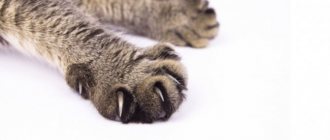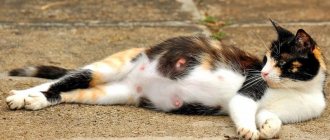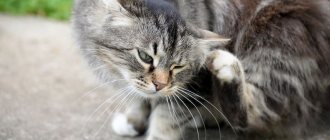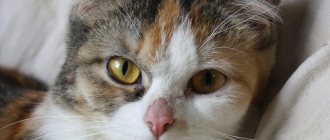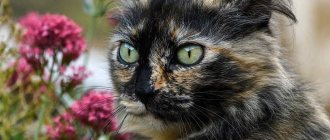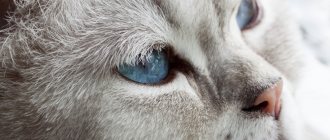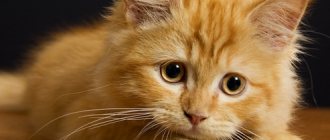Cats and claws
In this article, I will explain why cats change the sheath of their claws, why this happens, and how to help keep your cat's claws healthy and strong.
Read on to find out more. Cats grow fur all year round and twice a year, as the seasons change, they go through a major shedding process to ensure they have the appropriate coat for the upcoming warmer or cooler weather. Cats also change their whiskers and eyebrows, and sometimes the sheaths of their claws.
Since its sheath is very similar to a full cat's claw, for a new cat owner to find a cat's claw sheath for the first time at home may seem like a strange and alarming sign, but changing claw sheaths is a normal process for any domestic cat and is not a sign of illness.
What is a claw sheath?
Your cat's claws are made of tough, keratin protein that is very strong and durable. The claws are so strong in order to support the weight of the cat while climbing trees, curtains and other vertical objects in their environment. However, unlike dog nails, which continue to grow unless they are trimmed or worn down by walking on hard, rough surfaces, cat nails grow to a certain point of self-limitation, after which they stop growing in length.
While dogs may have problems with overgrowth of nails curling inward and growing into the pads of their toes, cats' nails will not continue to grow and grow unless the growth is artificially stopped.
The sheath is the outer layer of the claw itself, and claws have a layered structure and grow in layers, starting with the newest growth in the center and the oldest layers of growth on the outside.
Why do cats shed the sheaths of their claws?
To remain functional, a cat's claws need to be strong, sharp and sharp, which means that when the sheath of the claw starts to get a little tight at the tip, your cat will shed it off the claw to reveal a new, strong and sharp claw. A domestic cat's skin renews itself on a cyclical basis every three months - meaning that every three months or so, your cat will replace all of its previous claws with new ones.
Scratches and healthy claws
Cats need to scratch things to keep their claws sharp and short enough to be practical, and this process helps remove old layers of claws. To help your cat change its claws, install a scratching post or sisal post in your home!
Scratching things also allows your cat to exercise the muscles in her hands and feet by extending and retracting her claws, keeping them in good condition and allowing your cat to grasp, lift, catch and hold prey.
Provide your cat with a scratching post or a place to scratch, otherwise she will almost certainly find an alternative on her own, such as the living room rug, the legs of your sofa, and the like.
If your cat's claws grow too slowly for the animal to shed the claw sheaths on its own, you may need to trim the very tips of the claws, being careful not to damage the blood- and nerve-rich living tissue in the claws, which will bleed profusely if damaged. Also, an acute injury will cause pain and be a nuisance for your cat.
Are cat bites dangerous for humans?
Cat bites and scratches should not be ignored. They can lead to serious infections such as Pasteurella multocida, which occur when bacterial organisms of the Pasteurella species enter the body through punctures in the skin. This can lead to inflammation and suppuration of the subcutaneous tissue. Cats also often harbor the potentially dangerous organisms fusobacterium and streptococcus species, which can cause a wide range of infections such as tonsillitis and scarlet fever, as well as the bacteria bartonella henselae, which can cause a condition called cat scratch fever.
Does a cat change its claws?
Soon after we got a kitten at home, I heard my eldest daughter’s alarmed cries: “Daddy! Our Petya seems to have lost his claws! Several "claws" were found lying quietly on the living room carpet. I had to give the child a short lecture - cats not only shed twice a year! Not only do they grow a new mustache! About once every three months, the outer shell of their claw peels off. It looks like the cat has really lost it! But upon external examination it is clearly visible - everything is in perfect order, all the claws are in their place. It's OK!
How does a cat's claw work? The claw is made primarily of keratin, a tough and incredibly strong protein that forms a sheath around the living soft part containing blood vessels and nerves. Claws are vital for a cat. Notice how, in moments of danger, the animal uses its claws to climb to the top of the tree. The claws are so strong that they easily hold the weight of their “owner”.
Unlike dogs, cat nail length is usually “self-regulating”—meaning no additional input is required on your part (with a few exceptions, of course). The claw grows in layers - “new” layers are born in the core, and old ones gradually appear “from the very edge”. The “oldest” layer is called the shell, which peels off over time.
Why is this happening? As you and I already know, it is vital for a cat to keep its claws in perfect order - sharp, of optimal length. A cat knows how to take care of the health of its claws itself - it regularly “sharpenes” them (that is, checks the “workability” of the topmost layer). In everyday life, we observe how a cat, using an object that catches its eye, begins to scratch and scrape along it with its claws (“sharpening its claws”). At one point, the upper shell peels off, making room for a new, stronger and healthier one. This happens about once every three months! Of course, we hope that you have chosen the “right” scratching post for your furry pet and are saved from numerous problems!
Some general tips and recommendations. Now you, dear readers, know what exactly we mean by the phrase “sharpen your claws.” Among other things, by “exercising” on the scratching post, the cat does exercises and keeps the paw muscles toned!
Do you have a vitamin D deficiency?
Vitamin D levels can be determined using a blood test for 25(OH)D levels.
- less than 20 ng/ml (50 nmol/l) is defined as deficiency;
- from 20 to 30 ng/ml (from 50 to 75 nmol/l) - insufficient level;
- more than 30 ng/ml (75 nmol/l) is an adequate amount.
According to the clinical guidelines of the Russian Association of Endocrinologists, it is recommended to maintain the concentration of 25(OH)D in the range from 40 to 60 ng/ml (100-150 nmol/l).
Our body can independently produce calciferol, but there are risk groups that need to control the level of this microelement:
- people with dark skin color, as the ability to absorb UV radiation is reduced;
- working at night, constantly staying indoors or preferring closed clothing;
- people with metabolic disorders (in particular obesity);
- elderly population (with age, the ability to synthesize the vitamin decreases);
- those who prefer a restrictive eating style, as a result of which the diet does not contain sufficient amounts of vitamin D;
- low birth weight children;
- women taking oral contraceptives.
Claw growth: Why cats sharpen their claws
When retracting the claws, which have a scaly shell, the cat feels discomfort. That is why she begins to sharpen her claws on various surfaces in order to remove the exfoliated membrane from her nails. In natural conditions, trees that cats like to climb are used for this purpose, and in domestic conditions - any available objects, including furniture. To prevent this, you need to purchase a special scratching post or tips for claws.
There is another reason why cats sharpen their claws. On their paws there are special glands from which a secret is released that is inaccessible to the human sense of smell, but accessible to other cats. During the period, cats mark their territory, especially if there are several of them in the house.
Help at the veterinary clinic
The extent of surgical intervention is determined by the doctor after a thorough examination of the animal. He evaluates the depth of the ingrowth, the degree of inflammation, and the general condition of the cat. If there are no complications, the doctor removes the problematic nail with a special tool, having previously treated the pad with an antiseptic. If inflammatory processes have already begun to develop, the operation is performed under local anesthetic. During the procedure, the veterinarian opens the abscess to remove the claw, pus, and clean out the wound. But very advanced cases require general anesthesia.
Similar article: Main symptoms and rules for treating microsporia in cats
After the manipulations, the doctor applies a sterile bandage with antibacterial ointment to the furry patient. To neutralize the inflammatory process, he prescribes a course of antibiotics, and for a speedy recovery, he prescribes mineral and vitamin complex preparations. If the animal is too weakened, it adds drugs that strengthen the immune system to the treatment regimen.
During the rehabilitation of the furry, it is necessary to regularly change the bandages. At the same time, you should not glue them with adhesive tape, so as not to further injure the surrounding tissues. If the cause of an ingrown toenail is genetic, the problem is likely to recur. During a relapse, it is best not to treat the animal yourself, but to contact a veterinarian for a second course of treatment.
After the manipulations, the doctor applies a sterile bandage to the cat.
Why do they release claws?
It often happens that the cat marks time or lies on its knees and releases its claws at this time. Why a cat releases its claws is very important to know. After all, many owners begin to trim their cat’s claws and scold her when she puts out her claws at the wrong moment, but this is not recommended.
In fact, the phenomenon when a cat moves its paws and this is accompanied by the release of its claws is called a “milk step”. This comes from childhood, when kittens, when feeding on mother's milk, press on the mother's mammary glands with similar movements. Usually a milk step is a sign of affection from a cat, so you should never scold it. If these movements cause you discomfort, simply purchase soft silicone claw attachments.
general information
Condylomas are a benign tumor formation that is “located” on the epidermis or mucous tissues and looks like warts and papillae. Single specimens (about 7 mm) or entire “colonial formations” (up to several tens of mm) of condylomas settle on the body of women and men and often resemble cauliflower in appearance. The color of these substances ranges from flesh-colored to brown. Condylomas are viral in nature, so such problems can even occur in children (during childbirth from an infected mother). As long as the growth has not reached the epidermis, the person does not pose a threat to others; the risk of infection increases if the growths are located in the epidermal layer. Condylomas are usually divided into two types:
Main causes of delamination
Three reasons why a cat's claws completely peel off.
- Growth of claws. Most often, a cat's claws peel off due to their growth, which is accompanied by renewal of the stratum corneum and placement of the claw in a special scaly sheath. It comes off over time and causes separation. At home, you should use a scratching post.
- Incorrect care. When a cat's claws peel off after a haircut. Detachment can begin due to improper care of the claws, namely due to sloppy trimming, which can greatly injure the claws. We wrote in more detail about how to trim a cat’s claws.
- Lack of vitamins. If there is a lack of essential nutrients that can enter the cat's body with food, claw separation may begin.
The first two reasons are absolutely natural. Particular attention should be paid to the third point.
The cat's claws match the color of the outfit
Fungal infection
Fungal infection of the claws (onychomycosis) in cats is one of the most severe, difficult to diagnose pathologies caused by pathogenic fungi of the genus Microsporum and Trichophyton (dermatophyte fungi).
The development of mycoses is facilitated by decreased immunity, unfavorable living conditions, lack of hygiene, and internal diseases. As a rule, fungi affect not only the claws, but also the tissues of other parts of the pet’s body. Note that fungal infection is dangerous not only for cats, but also for humans.
Symptoms
Symptoms, the first signs of fungal infections, may not be immediately noticeable. Most often, the disease occurs in a chronic form.
Symptoms of onychomycosis:
- fragility, discoloration, curvature of claws;
- the appearance of wounds, ulcers, crusts between the fingertips;
- lameness, pain when walking;
- brown claws at the base;
- alopecia, erythema on the claw bed;
- decreased activity;
- formation of hairless, rounded areas on the paws and body;
- unstable temperature;
- deterioration in wool quality;
- change in behavior (lethargy, drowsiness, depression);
- an unpleasant odor emanating from a fungus-affected paw.
The skin licks the sore paw and does not allow you to touch it, experiencing acute pain. The skin near the affected claws is reddened and swollen.
Treatment
Treatment of fungal infections is based on complex therapy. The veterinarian prescribes the methods after diagnosis. In therapy, antifungal complex drugs are used for internal and external use. Damaged by fungi, deformed claws are removed surgically.
In addition to fungicidal agents in ointments, drops, tablets, liniments, animals can be prescribed wound-healing, decongestant, antibacterial drugs, vitamins, homeopathy products, traditional medicine (decoctions, tinctures of medicinal herbs are used in the form of baths to wash affected areas of the skin).
Important! The prognosis is cautious. A cat that has had fungus, even after treatment, is a carrier of fungal spores.
Antifungal drugs
In the treatment of onychomycosis and mycoses of various etiologies in veterinary medicine, antifungal drugs are used, which are available in tablets, sprays, aerosols, ointments, gels:
- Ketoconazole;
- Fluconosal;
- Fungoterbin;
- Lamitel spray;
- Mycozoral;
- Terbinafine;
- Clotrimazole;
- Intraconazole;
- Lamisil;
- Flucostat;
- Fungoterbin;
- Mycomax.
Treatment at home
Only a few know or have heard about what to do if a cat has an ingrown claw in its pad. A person’s first instinct is always to straighten the claw and pull it out with his hand. But this is absolutely forbidden.
To help his cat, the owner must have special clippers for trimming animal claws. The instrument should be disinfected with alcohol (cologne or vodka). The place where the claw has grown is also moistened with an antiseptic. An ingrown toenail is cut off before reaching the pink part where the blood vessels pass, so as not to damage them .
After trimming, the nail is removed from the pad by grabbing it by the edge with nippers or tweezers, with a sharp movement in the opposite direction of growth. It is important to do the removal quickly, as the procedure is painful and the cat will not like it. As a rule, the nail comes out easily without damaging nearby tissues.
© shutterstock
The place from which the defective nail was removed must be disinfected with hydrogen peroxide or furatsilin solution. You can also apply antibacterial ointment to the wound to prevent infection. The rest of the nail is shortened to the maximum possible height using a nail clipper.
Self-treatment can be carried out only if there is no inflammation at the site of ingrowth. If, upon examination, swelling and redness are detected at the site where the nail enters the soft tissue, then it is not recommended to treat the cat’s nail at home. Contact a specialist.
Panaritium (inflammation of the claw bed)
If we compare them with dogs, felons (inflammation of the claw bed) are much less common in cats. Normally, near the base of the claw there is a layer of dense, tough skin that protects the organ from negative environmental factors. Due to injuries, this layer is damaged, as a result of which bacterial and fungal microflora gain access to the soft tissues.
Most often, this disease occurs in cats living in rural areas and constantly walking outside.
Symptoms
The pathology has quite characteristic symptoms:
- Since inflammation is accompanied by severe pain, the cat prefers not to lean on the affected paw. If he has to do this, the pet hisses and meows strongly, “with anguish.”
- For the same reasons, the animal constantly licks and even gnaws its own paws.
- When examining the paws, it is clearly noticeable that the skin around the base of the claws is red, swollen, hot, and in many cases exudate oozes from there.
Treatment
As in the previous case, the treatment is not particularly difficult:
- The affected paw is kept in a saturated solution of Epsom salts (Epsom salt) three times a day for 10-15 minutes, or in a saturated solution of ordinary sodium chloride (table salt). This helps to pull exudate from the tissues and stop the inflammatory process.
- In severe cases (especially with the interference of putrefactive microflora), complete excision of the claw, and in some cases of the entire finger, is recommended.
- In most cases, broad-spectrum antibiotics are prescribed.
